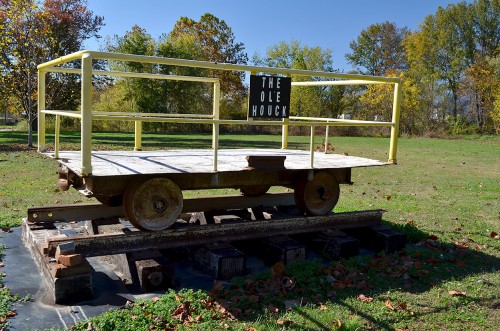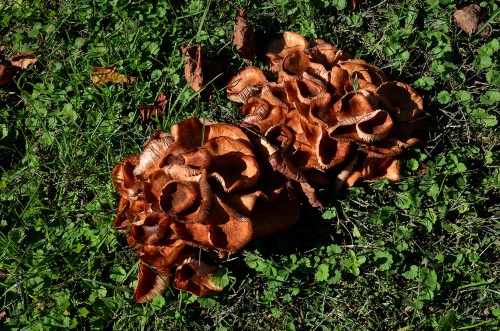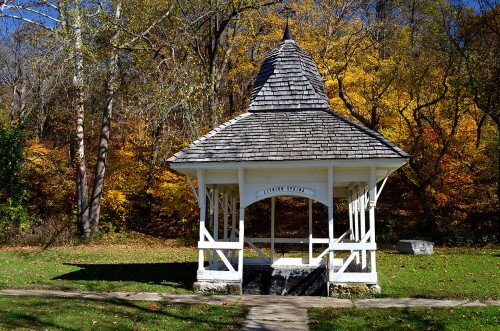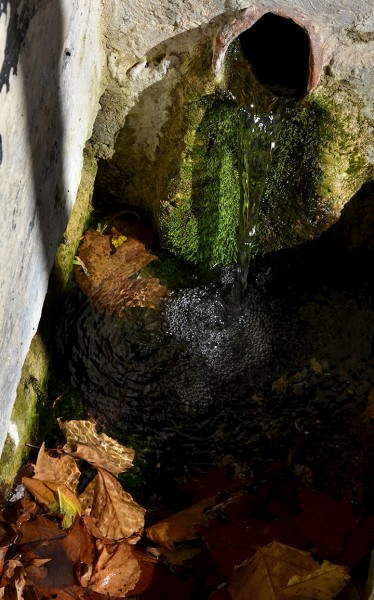 We had to take Wife Lila and her buddy Jane Rudert McMahan to the airport in St. Louis way too early in the morning. Mother and I had lunch at Pappy’s Smokehouse, then paid $2.55 a gallon for gas at Peveley before hopping on Hwy 61 to take the scenic route home.
We had to take Wife Lila and her buddy Jane Rudert McMahan to the airport in St. Louis way too early in the morning. Mother and I had lunch at Pappy’s Smokehouse, then paid $2.55 a gallon for gas at Peveley before hopping on Hwy 61 to take the scenic route home.
Just south of St. Mary and just north of Perryville, I saw a sign pointing down M to Lithium. Since our goal is to find a road we had never been on before, we set our sights on Lithium.
Before long, we spotted the city limits sign of a hamlet so small they didn’t even bother to show the population. (The 2010 census reported 89 people, 28 households and 22 families living there, but those figures may have included folks living in rural Perry county outside Lithium proper, an AP account said.) Lithium had a ZIP Code of 63775, but it has since been declared by the United States Postal Service to be “Not Acceptable – Use Perryville.”
This well-kept church didn’t have a name on it, but it is the St. John the Evangelist Catholic Church, organized in 1896.
The Ole Houck
 The village has a sizable park which contains this artifact labeled “The Old Houck.” It looks more like a cart you’d find in a mine than a railroad, but I don’t know exactly what it was for.
The village has a sizable park which contains this artifact labeled “The Old Houck.” It looks more like a cart you’d find in a mine than a railroad, but I don’t know exactly what it was for.
Fungus? Mushroom? Toadstool?
 These brown somethings were dotting the park here and there, particularly where there was a tree stump or other organic matter. I’m assuming it was some kind of fungus.
These brown somethings were dotting the park here and there, particularly where there was a tree stump or other organic matter. I’m assuming it was some kind of fungus.
Lithium Spring
 The most interesting thing for me was this white, shake shingled gazebo with a sign “Lithium Spring.” Inside the structure was a pit that contained a pipe with clear water running into a basin from one side and going out a grate on the other. The flow wasn’t as strong as the artesian well outside Marble Hill, but it was steady.
The most interesting thing for me was this white, shake shingled gazebo with a sign “Lithium Spring.” Inside the structure was a pit that contained a pipe with clear water running into a basin from one side and going out a grate on the other. The flow wasn’t as strong as the artesian well outside Marble Hill, but it was steady.
Mother wanted to taste the spring, so I emptied a plastic bottle and handed it over to her. “Tastes like water,” was her verdict.
A contributor to findaspring.com said it is “It is a highly mineralized spring, more like water for healing…Not your everyday drinking water but will definitely start to heal you. I drink it every once in a while, additionally to my regular Spring water from Mountain Valley Spring.”
Lithium had TWO big springs
 The State Historical Society of Missouri’s website of Perry County Place Names, 1928 – 1945, has this information about the town and springs:
The State Historical Society of Missouri’s website of Perry County Place Names, 1928 – 1945, has this information about the town and springs:
- The town: A small town in the eastern part of Saline Township. It was surveyed and laid out as a town in 1822 by C.F. Laurence. The first settlers were Dr. Henry Clay Tish, R.P. Dobbs, and James G. Christian, who came from Illinois and settled at this place where they found two springs of mineral water known as lithium, because containing one of the lithium salts. The town grew rapidly because of the springs and was incorporated in 1883.
- [Note: a reader sayid Henry’s last name was actually “Fish,” not “Tish.”
- The springs: Two large springs located in the northern part of the county in the present town of Lithium. One of the springs is owned by the town; the other by Mrs. Richard P. Dobbs, wife of one of the first settlers.

Delightful!! Can’t wait to fill up…..
Lithium is corrosive and requires special handling to avoid skin contact. Breathing lithium dust or lithium compounds (which are often alkaline) initially irritate the nose and throat, while higher exposure can cause a buildup of fluid in the lungs, leading to pulmonary edema. The metal itself is a handling hazard because of the caustic hydroxide produced when it is in contact with moisture. Lithium is safely stored in non-reactive compounds such as naphtha.[118]
Beautiful church and loved the story behind the “town.” Sort of reminds me of Brigadoon . . . is it really there or just a figment of the imagination?
Lithium was a stop on the old Houck railroads, Cape Girardeau & Chester and Cape Girardeau Northern, so it is appropriate that there might be some local acknowledgement of that fact. The car in the photo is a piece of Maintenance of Way equipment known as a Speeder Cart. It would have been connected by link and pin coupling to a Speeder as a trailer of sorts for hauling gear or materials for repair or maintenance of track. A Speeder is a self-propelled conveyance ridden by Maintenance of Way section crews along the rails to work sites.
A look at Lithium on Google Earth will reveal the long – abandoned roadbed of the Cape Girardeau Northern to those with a sharp eye.
The currenty community of Lithium have set out to refurbish the park area, the item referred to as a railroad car is actuall from the mines in ste. genevieve Mo, and was placed there within the last year. It represents the area the railroad tracks ran thru the park long ago.
Back in the 1970s I wandered by car around the rundown north side of St. Louis looking for things historical. There was an old, worn painted advertisement painted on the side of a building with the words “Drink Lithium Springs Water” and a painting of a soda type bottle with a Lithium Springs label on it. I believe they bottled it and sold it.
The water was bottled and transported to St. Louis it was big business back in the day. Known for its healing properties.
In 1947, my father moved my mother, who was 23 at the time, to a house just below the spring… She had four little girls with her, ages 1 to 6.. My father worked in St. Louis and only came home on weekends. The house had no electric or running water. We had a well for washing and cleaning, but unfit to drink. We got our drinking water from the spring, as most of the town people did. My brother was born there at home the next year. There was a one room school and when I started school in 1948, I was the only one in first grade. It was a perfect place for kids but it was too hard on my mother being so young and raising a bunch of kids literally by herself..so we moved back to St. Louis in 1949.
That probably would be where my great Uncle Gilbert Feltz lived. Wright along the creek
I was born in 1948 my dad’s family all lived and grew up there. I love these stories.
Most likely Lithium isn’t the same as it once was. When I was younger, my mom had friends that lived there and we would go visit them often, more so in the summer months. And as an adult now, it’s not even the same as back then. I currently reside in Lithium along with my husband and 4 yr old granddaughter. We moved here in September 2016. There is a creek that runs behind our property under the road to tge park and the Spring House. The water is probably as good as it was back in your day. I was just told that Lithium once was a booming lil place. Sad to say, it’s definitely not like that now. For the most part it’s quiet and peaceful place to live. I live on Blue Springs Ln.
I’ve been by there several times in the last 10 years. I would like to have seen it when it was booming.
Yes, Gib Feltz lived there. You went through the town and the last curve if you went straight it would be his driveway
The water was bottled and transported to St. Louis it was big business back in the day. Known for its healing properties.
My grandfather Harold Graff Sr. lived in Lithium MO. I spent many summers in Lithium helping with the farm work in the Bois Brule Bottoms. We obtained our drinking water from the spring using large coke syrup bottles and kept them in the shade of pecan trees during the day. The adults always warned us not to step on the metal plate that funneled the water into the catchment because “we might knock in a dead mouse or something”. The Lithium Spring was legendary for it’s supposed healing benefits.
I just wanted to correct one of the founders names in your article on Lithium Springs. One of the founders was Dr. Henry Clay Fish (not Tish). He is buried at the Home Cemetery in Perryville near Richard Pound Dobbs, one of the other founders. Dr. Fish was the grandfather of my uncle’s wife.
Thanks for the correction. I’ll change it.
In the late 50s and early 60s, I both attended and then returned to teach at Bayless High School in South St. Louis County. It was there that I came to know — then revere — Estelle Elmore, who started teaching at Bayless in 1928, when it was a two-room school building. She remained there until her retirement in 1969, I believe. She ultimately served the district as a teacher, a principal, a temporary superintendent, and — in her later years — the formidable high-school librarian. At the time of her death, I learned that her maiden name was “Fish.” You can imagine my immediate assumption, when I read of the correction to the name of Dr. Henry Fish, that she was a descendent (perhaps the last?) of Dr. Fish.
I’m very familiar with the concept of the formidable school librarian. My wife served in that capacity in a middle school for about a decade. She wasn’t really formidable, though. She made the library (called a media center these days) a friendly and safe place for kids to gather. She told me that the most toxic room at most schools was the teachers’ lounge. It was there that a kid could acquire a label that would follow them until they left the school. She took a lot of those kids under her wing, and some still recognize her when she’s shopping.
I live in Lithium and nothing has changed much from my Childhood, with the exception of the Brick Apartment building burning and being replaced.
The old brick apartment building once served as a Tavern on one end, a store on the other end in the front and butcher shop in the back. My Grandma, Great Grandma, and My Great Grandma’s Mother were all born in Lithium.
My 4th Great Grandfather is Charles Frederick Lawrence. According to what I read, he owned the springs and gave it to the town, he and his brother opened a store in the area. He was married to Philomene Carron, who was 1/2 french and 1/2 native american.
Aimee G
I am told that I am somehow related I believe thru the Carron side of the family. A friend of my Stepmother did our ancestry and it is full of the name Carron.
My Grandfather is Amos Lawrence .
As a child I vaguely remember visiting family in the town where the minds are.
My maternal grandfather, Richard Graham Fish, grew up in Lithium played ball on the green that’s now the town park before he went off to St. Louis for medical school and then to practice in west Tennessee. He was one of six children of Frank Fenton Fish, himself the son of Henry Clay Fish (a Civil War vet) and Lily Graham. Frank ran the general store and served as postmaster until his death in the early 1940s. His father mother divorced, Henry Clay Fish moved to Florida, and Lily married Richard P. Dobbs, also of Lithium. My mother and her four sisters, and their cousins, visited Lithium frequently, as did my brother and I while we were growing up outside St. Louis. I last visited in 2011 with three of my children, my brother and his wife and my mother’s youngest sister. The water in the spring tasted as good as ever! And, I saw Arno Kracht’s mention of Estelle Elmore (Aunt Stella, as I knew her). She was, indeed, a granddaughter of Henry Clay Fish, daughter of Frank Fish and a very special aunt and great-aunt to many.